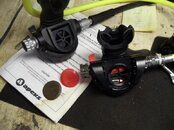LowDrag
Contributor
Sounds to me like a very well tuned reg doing exactly what it should do.
Verify the location of the leak in water. Even a finger tight connection should not leak (until it loosens further). The o-ring sealing that connection (if I understand you correctly) should already be installed in the hose. It may need to be check to see that it is not damaged.
Apparently I have never had a really well tuned reg then because my ScubaPro C300 never did that.
I seem to remember that I put an o-ring on the reg because there wasn't one. I will have to double check that....thanks.





